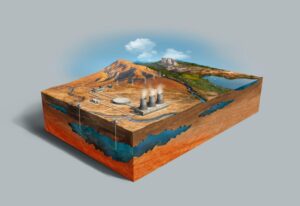Exploring New Technologies in Geothermal Energy: A Comprehensive Guide

Geothermal energy is one of the cleanest and most sustainable sources available today. It is a renewable energy source that can be tapped into for domestic and commercial purposes. It can reduce our dependence on fossil fuels, decrease the amount of carbon dioxide released into the atmosphere, and provide a reliable energy source for years.
In this article, we’ll explore the benefits of geothermal energy, the various technologies used to tap into it, and the potential pitfalls associated with using it. We’ll also cover the current state of geothermal energy, where it’s being used, and what the future may hold for this renewable energy source.
Introduction to Geothermal Energy
Geothermal energy is the heat from the Earth’s core that can be tapped into and used for various applications. This energy is considered renewable because it is constantly replenished and does not emit harmful pollutants into the atmosphere. It is also a very efficient energy source, as it can generate electricity and provide hot water for domestic use.
Geothermal energy is typically accessed through a process known as geothermal power plants. These plants utilize the heat from the Earth’s core to generate electricity. The heat is first collected from a geothermal reservoir and then transferred to a turbine, which generates electricity. This electricity is then sent to a power grid and distributed to homes and businesses.
Benefits of Geothermal Energy
Geothermal energy has numerous benefits, making it an attractive option for domestic and commercial applications. Firstly, it is a renewable energy source, and thus, it can help reduce our reliance on fossil fuels. Secondly, it does not emit any pollutants into the atmosphere; thus, it is more environmentally friendly than other energy sources.
Thirdly, geothermal energy is a reliable source of energy. Unlike solar and wind energy, which depend on the weather, geothermal energy is always available and can be tapped anytime. Lastly, geothermal energy is cost-effective and can provide hot water for domestic use and electricity for commercial purposes.
Disadvantages of Geothermal Energy
Although geothermal energy has numerous benefits, its drawbacks are also associated with it. Firstly, geothermal energy requires a significant upfront investment to access it. Secondly, the process of extracting geothermal energy can be difficult and expensive. Thirdly, geothermal energy might not be available in some areas due to geological or environmental limitations.
Fourthly, geothermal energy extraction can cause environmental damage if not done correctly. Lastly, geothermal energy plants can be noisy and disturb the surrounding wildlife.
Where is Geothermal Energy Being Used Now?
Geothermal energy is currently being used in many parts of the world, such as the United States, Iceland, New Zealand, and Chile. In the United States, geothermal energy is mainly used for electricity generation, while in Iceland and New Zealand, it is mainly used for hot water and space heating.
In Chile, geothermal energy is used for electricity generation and hot water. The U.S. is the largest producer of geothermal energy, supplying over 3,000 megawatts of electricity.
Advanced Geothermal Energy Technology
Over the past few years, many new technologies have been developed to make geothermal energy more accessible and efficient. One of the most promising technologies is fusion drilling, which utilizes lasers to create tunnels deep into the Earth. This technology can potentially make geothermal energy extraction more efficient and cost-effective.
Another advanced technology is Larson Radiator Norway, which uses hot water and electricity to generate electricity. This technology has the potential to increase the efficiency of geothermal energy production.
Fusion Drilling
Fusion drilling is a relatively new technology that uses lasers to create tunnels deep into the Earth. This technology can potentially make geothermal energy extraction more efficient and cost-effective.
Fusion drilling uses lasers to create tiny tunnels in the Earth’s crust. These tunnels are then filled with water and heated to create steam, which is then used to generate electricity. This technology can potentially reduce the cost of geothermal energy extraction and make it more accessible.
Larson Radiator Norway
Larson Radiator Norway is a new technology that combines hot water and electricity to generate electricity. This technology works by using a turbine to generate electricity from the heat of the hot water. The hot water is then cooled and reused in the process.
This technology can potentially increase the efficiency of geothermal energy production and make it more cost-effective. Additionally, it can reduce the environmental impact of geothermal energy extraction by reducing the amount of water used in the process.
Problems with Geothermal Energy
Although geothermal energy has numerous benefits, it also has some potential problems. Firstly, extracting geothermal energy can cause environmental damage if not done correctly. Secondly, the process of accessing geothermal energy can be expensive and complicated.
Thirdly, geothermal energy might not be available in some areas due to geological or environmental limitations. Lastly, geothermal energy plants can be noisy and disturb the surrounding wildlife.
The Future of Geothermal Energy
Despite the drawbacks of geothermal energy, many experts believe it has a bright future. The increasing demand for renewable energy and the advancement of new technologies make geothermal energy more accessible and cost-effective.
Furthermore, the increasing popularity of geothermal energy has led to the development of new technologies, such as fusion drilling and Larson Radiator Norway. These technologies can potentially make geothermal energy even more efficient and cost-effective.
Geothermal energy is a renewable energy source with numerous benefits, including reliability, cost-effectiveness, and environmentally friendly. It can generate electricity and provide hot water for domestic use. Accessing geothermal energy can be expensive and complicated, but new technologies, such as fusion drilling and Larson Radiator Norway, make it more accessible and cost-effective.
The increasing demand for renewable energy and the advancement of new technologies make geothermal energy more accessible and cost-effective. As such, geothermal energy will likely continue to play an essential role in our energy mix in the future.